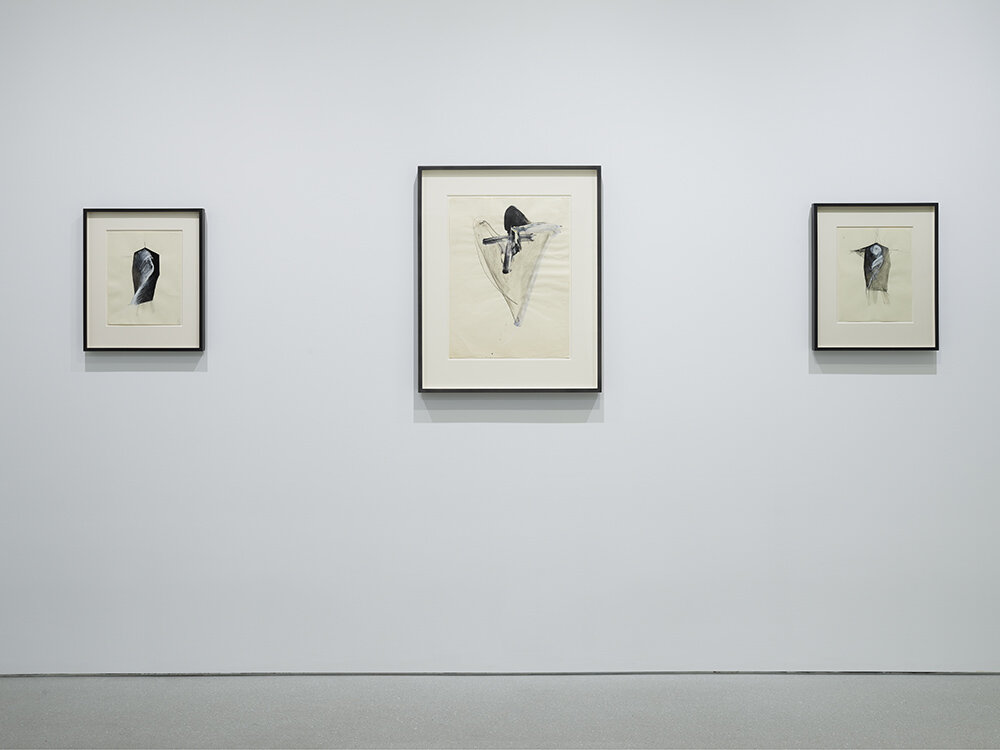Jay DeFeo: Transcending Definition
JAY DEFEO
Transcending Definition Jay DeFeo in the 1970s, 2020, installation view
© 2020 The Jay DeFeo Foundation / Artists Rights Society (ARS), New York
Photo: Robert Divers Herrick
Courtesy Gagosian
Jay DeFeo, the late, California-based artist who pushed the boundaries of each medium she mastered, will be now remembered at the Gagosian San Francisco. Jay DeFeo: Transcending Definition, organized in association with The Jay DeFeo Foundation and opened on September 10, is less than a thirty-minute drive from Larkspur, where, in the 1970s, the artist was inspired to create the featured paintings, works on paper, and photographs. This is the first of Gagosian’s fall exhibitions, reopening a space that has been closed to the public since March.
DeFeo’s art, the most recognizable of which is her painting, The Rose, an iconic work that took eight years of applying and then chiseling through dense paint, is strikingly familiar—yet her name seems to fail the “household name” test. As I texted my mother, an NYU art history graduate and retired Sotheby’s professional, “Have you ever heard of Jay DeFeo,” to which she replied, “No, is that a friend of yours,” I wondered how DeFeo’s name, which echoed through the sprawling ocean-side cliffs and mountains in California, missed the East Coast art scene, despite being featured in MoMA’s legendary Sixteen Americans (1959-60) and the more recent Whitney retrospective in 2013.
JAY DEFEO
Transcending Definition Jay DeFeo in the 1970s, 2020, installation view
© 2020 The Jay DeFeo Foundation / Artists Rights Society (ARS), New York
Photo: Robert Divers Herrick
Courtesy Gagosian
To help answer this question, we must look at the surrounding art landscape by which this epoch is defined. In New York, during DeFeo’s famous Marin County period, the art world was enthralled with Frank Stella and Andy Warhol, both of whom exclusively worship the exterior. Frank Stella, who famously said, “What you see is what you see,” and Warhol, who said, “just look at the surface of my paintings and films and me, and there I am. There’s nothing behind it,” thereby distinguishing their emphasis on and idolization of the surface, as well as their rejection of interpretations that delve deeper than the presented aesthetic. Art managers consequently are able to control how these works are read, while establishing the standards by which “high art” is evaluated.
DeFeo, conversely—and simultaneously—was describing her works as “beings suspended in space and time” that “transcend the definition of the literal objects from which they are derived.” She fused work that was overtly representative with the abstract and the elusive, which gave her quotidian objects a sense of mystery. Her lack of consistency and uniformity leaves her work without classification. “Only by chancing the ridiculous, can I hope for the sublime,” DeFeo muses, leaving us with the often disregarded element of “magic” within her artistic practice.
JAY DEFEO
Pend O'Reille No. 1 (Eternal Triangle series), 1980
Acrylic and tape on Masonite
48 x 72 1/8 in
121.9 x 183.2 cm
© 2020 The Jay DeFeo Foundation / Artists Rights Society (ARS), New York
Photo: Robert Divers Herrick
Courtesy Gagosian
Jay DeFeo: Transcending Definition, features her work from the decade after the completion of her iconic, The Rose painting – a chapter of experimentalism, where abstraction, texture, color and media are integrated together to create her own “visual vocabulary.” Using the medium of painting, sculpture, jewelry, photography, and photo collages – the Gagosian San Francisco houses a variety of her fearless works that challenged, and continues to challenge, the art world’s rigidity. From the acrylic-on- Masonite painting White Shadow (1972) to the Tripod series (1975–77), to her Jewelry series (1977–78), viewers can witness her exploration and growth as a visual artist. DeFeo’s unique talent of turning the familiar into the mystic is unmissable. While DeFeo’s name might seldom fall from the New Yorker’s mouth, her work impacts the freedom and depth of artistic expression today.
Jay DeFeo: Transcending Definition is on view until December 11, 2020.










